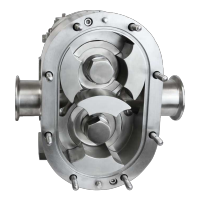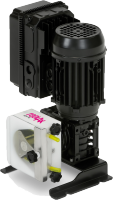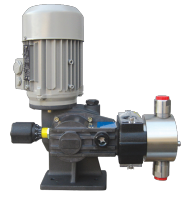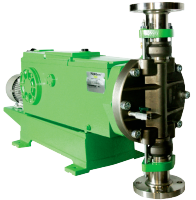Dosing, metering injecting pumps review
The task of carrying out an overview of dosing and metering pump technology is one that is not straightforward due to the vast number of applications and the resultant diversity of pump types employed for such purposes. Even the definition of what's being discussed is confused between industries - one man's dosing is another's injecting and someone's metering is another's dosing.
This diversity isn't surprising when one considers the number of industries involved including toiletries, detergents, pharmaceuticals, water and waste treatment, food and beverages, power generation, chemical processing, petrochemicals and oil and gas recovery. Liquids can be anything from fragrances and colours for toiletries and food, acids and alkaline solutions for chemical processes and water treatment, hydrocarbon condensate from crude oil extraction to liquid CO2 in cryogenic duties.
Considerations
The starting point, as with any pump application, is to identify the flow rate, the differential pressure and, as it's a dosing application, the level of accuracy. Having established these basic facts the fluid's characteristics, such as viscosity, solids content, abrasiveness, corrosiveness and toxicity are required. This information will tell you the scale of the job and in which general pump direction you are heading. Higher pressures, levels of accuracy and lower flows and viscous liquids will veer towards gear, piston, plunger and diaphragm metering pumps while lower pressures, levels of accuracy and higher flows will lead you towards peristaltic, air operated diaphragm (AOD, vane or even centrifugal pumps.
Next are the specific requirements of the operating environment and industry specific considerations such as ATEX, API or the various levels of hygienic and sanitary design required by the food and pharmaceutical industries. These standards can have quite an impact on the choice of pump particularly if you don't have access to a large product range. Engineers often settle for second best as their options are limited by what's offered to them with ATEX certification, EHEDG approval or conformity to API 676 etc.
Lastly, there is the method by which the pump will be controlled – will it be a simple manual adjustment, timer, variable speed drive, 0 – 5 mA signal or a process control system such as PROFIBUS.
Dosing and injecting
So what makes a pump a dosing pump and not a metering pump? At AxFlow our definition is quite simple – a metering pump is one that always delivers a controlled volume irrespective of the fluid's properties and the pressure it's pumping against
So, let's start with pumps that don't do this - which is most of them including many that are regularly described as "metering"pumps.
If the flow is over 1 m3/hr, at relatively low delivery pressures and with a liquid that's not too viscous or heavy, then a centrifugal pump can be considered. With a VSD and a bit of effort, a predictable, controllable flow can be achieved with a centrifugal pump, and with flows measured in cubic meters they often represent the most cost effective solution. H400A big advantage is that with so many to choose from, considerations such as chemical compatibility, ATEX and hygienic requirements can be catered for. At flows of below 10 m3/hr, and where an accuracy of 3% is acceptable, then Air Operated Double Diaphragm (AODD) pumps are commonly used. They can be easily adjusted, cope with viscous and corrosive liquids, will suck out of a barrel/IBC, can be hygienic, ATEX complaint, are moveable and not excessively expensive. AODD pumps are a popular choice in the water industry for water treatment additives, chemical processing for "injecting" and the food industry for adding colouring and cleaning agents.

AODD Pump
When it comes to light, non-lubricating fluids such as alcohols and solvents then vane pumps are very often the best solution as they are self-lubricating and can (with the correct design) cope with low NPSH. At AxFlow we have had particular success with vane pumps in biodiesel processes for blending methanol and introducing scale and corrosion inhibitors inhibitors.
Gear pumps can be used where space, a smooth flow, or noise is an issue such as medical and pharmaceutical applications. They can be accurately controlled and made from chemically resistant materials to deliver up to 10 m3/hr at pressures of 20 bar. But, as their gears wear their performance alters and changes in pressure and fluid viscosity will affect the volume they deliver.
Thick liquids and those that need a gentle pumping action as found in the food industry are often best dosed with external 420530 circumferential piston (ECP) pumps. Not to be confused with their less accurate cousin the rotary lobe pump, ECP pumps offer a low shear pumping action and due to the long sealing path, a highly controlled delivery volume to almost that of a true metering pump. They can also handle extremely viscous fluids to over 500,000 cP and offer the very highest of hygienic designs. Another low shear option is that of eccentric rotating disc pumps as they too can be can be hygienic, are self-priming and will run dry. Most importantly eccentric rotating disc pumps will completely clear a line, a particularly useful trait when dosing a finite quantity of liquid, and one that also negates the need forMouvex SLC air blasting or pigging to empty a line of unwanted fluid.

ECP Pump
For high pressure "injection" dosing duties piston pumps are the traditional solution as they are simple, use a well understood principle and can be constructed into multiple chamber designs to suit different requirements. But, despite their precise sounding description of "injection" pumps, like all of the other dosing pump types, their delivery volume will vary as components wear and when operating against differing back pressures.
Lastly, we come to peristaltic pumps, a very common solution for dosing applications as they are simple, easy to regulate, chemically resistant, relatively inexpensive and versatile. They are popular from laboratories and cleaning equipment to medium sized chemical processes that require a range of different chemicals and also for the introduction of thick slurry type additives such as lime dosing in the water industry. RealAx APY 10Despite the fact that peristaltic pumps are commonly described as metering pumps they fail AxFlow's definition of a metering pump. Unless the delivery flow is closely monitored and the tubes replaced on a regular basis, peristaltic pumps will display quite high variations in delivery volume because of the elongation and hardening of the tube material. Furthermore, like all of the previous pump types, their output too will be affected by the pressure they are working against.

APY Pump
Metering
There are only two common pump types that guarantee a fixed delivery volume over time and against varying back pressures, these being reciprocating diaphragm pumps (that come in two varieties, piston and hydraulically actuated) and plunger pumps.
OBL-MD For mild and less-corrosive liquids, the first reciprocating diaphragm pump variant with mechanical diaphragms is favoured by most for metering pressures up to approximately 10 bar and flows of 1,000 l/hour. They are popular as the flow can be modified by either shortening the stroke or by its frequency, plus they can be arranged in multiple banks of units, can be controlled by all manner of command signal and will clear a line. Reciprocating pump technology can provide repeatable accuracies as low as 0.5% even at very low metering flow levels.
For higher pressures (up to 400 bar in the case of API models) and higher flow applications, plunger pumps are used. The standard plunger pump head, consisting of a housing, displacement plunger, seal arrangement, pump valves and suction/discharge side connections, is commonly used where high pressures and high flow rates are encountered. The simple design and small number of components allows a low dead volume and high volumetric efficiency. However, plunger pumps don't offer the pressures nor their efficiencies. Consequently hydraulically actuated didiaphragm pumps have emerged over the past couple of decades which offer both the containment of the mechanical diaphragm and the pressure capabilities of plunger pump. containment of a diaphragm pum
PulsarHydraulically actuated, double diaphragm pumps will reach pressures of up to 1000 bar with a leak-free operation, can provide a smooth product flow across a wide operating range, including low speeds and will accommodate the widest possible range of duties for all critical pressure processes. They can be constructed from a range of chemically resistant materials and offer excellent containment due to the pressurised hydraulic fluid.


OBL Pump Pulsafeeder
Summary
Do you care if the dosing volume changes over time or as a result of system and environmental factors? If the answer is yes, then you are limited to a very select ban of true metering pumps. If on the other hand your application isn't so demanding and you are able to periodically monitor the delivery flow to make sure it's what you want, then possibly a much wider range of options is available to you than is often imagined.